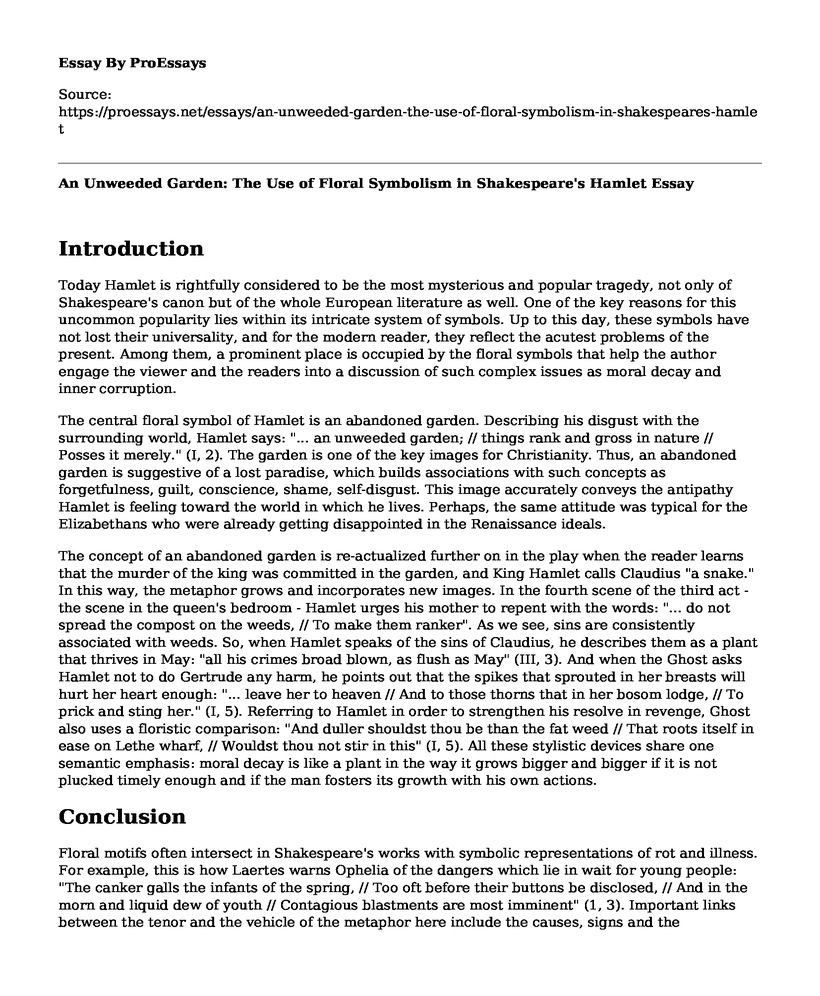Introduction
Today Hamlet is rightfully considered to be the most mysterious and popular tragedy, not only of Shakespeare's canon but of the whole European literature as well. One of the key reasons for this uncommon popularity lies within its intricate system of symbols. Up to this day, these symbols have not lost their universality, and for the modern reader, they reflect the acutest problems of the present. Among them, a prominent place is occupied by the floral symbols that help the author engage the viewer and the readers into a discussion of such complex issues as moral decay and inner corruption.
The central floral symbol of Hamlet is an abandoned garden. Describing his disgust with the surrounding world, Hamlet says: "... an unweeded garden; // things rank and gross in nature // Posses it merely." (I, 2). The garden is one of the key images for Christianity. Thus, an abandoned garden is suggestive of a lost paradise, which builds associations with such concepts as forgetfulness, guilt, conscience, shame, self-disgust. This image accurately conveys the antipathy Hamlet is feeling toward the world in which he lives. Perhaps, the same attitude was typical for the Elizabethans who were already getting disappointed in the Renaissance ideals.
The concept of an abandoned garden is re-actualized further on in the play when the reader learns that the murder of the king was committed in the garden, and King Hamlet calls Claudius "a snake." In this way, the metaphor grows and incorporates new images. In the fourth scene of the third act - the scene in the queen's bedroom - Hamlet urges his mother to repent with the words: "... do not spread the compost on the weeds, // To make them ranker". As we see, sins are consistently associated with weeds. So, when Hamlet speaks of the sins of Claudius, he describes them as a plant that thrives in May: "all his crimes broad blown, as flush as May" (III, 3). And when the Ghost asks Hamlet not to do Gertrude any harm, he points out that the spikes that sprouted in her breasts will hurt her heart enough: "... leave her to heaven // And to those thorns that in her bosom lodge, // To prick and sting her." (I, 5). Referring to Hamlet in order to strengthen his resolve in revenge, Ghost also uses a floristic comparison: "And duller shouldst thou be than the fat weed // That roots itself in ease on Lethe wharf, // Wouldst thou not stir in this" (I, 5). All these stylistic devices share one semantic emphasis: moral decay is like a plant in the way it grows bigger and bigger if it is not plucked timely enough and if the man fosters its growth with his own actions.
Conclusion
Floral motifs often intersect in Shakespeare's works with symbolic representations of rot and illness. For example, this is how Laertes warns Ophelia of the dangers which lie in wait for young people: "The canker galls the infants of the spring, // Too oft before their buttons be disclosed, // And in the morn and liquid dew of youth // Contagious blastments are most imminent" (1, 3). Important links between the tenor and the vehicle of the metaphor here include the causes, signs and the consequences of rotting. Rot is rapidly spreading, often pushing the normal fetus out. You can get rid of it only in a cardinal way by removing the damaged area. Thus, Laertes implies that an unformed mind is still quite prone to negative influences which become easily enrooted, and can quickly engulf the whole inner life of a young person.
Thus, many symbols in Hamlet are introduced through floristic metaphors. Though this imagery seems to be domesticated and quite innocent, it harbors rather complex philosophical, ethical, and religious interpretations.
Works Cited
Shakespeare, William. The Tragedy of Hamlet, Prince of Denmark. Edited by Barbara A. Mowat and Paul Werstine. Folger digital texts, www.folgerdigitaltexts.org/html/Ham.html.
Cite this page
An Unweeded Garden: The Use of Floral Symbolism in Shakespeare's Hamlet. (2022, Feb 12). Retrieved from https://proessays.net/essays/an-unweeded-garden-the-use-of-floral-symbolism-in-shakespeares-hamlet
If you are the original author of this essay and no longer wish to have it published on the ProEssays website, please click below to request its removal:
- World of Crime in Great Expectations Essay
- Mystery of Death on Literature Examples Essay
- To Room Nineteen and Pride and Prejudice Passage Analysis Essay
- The Effects of Postpartum Depression of Women in The Yellow Wallpaper
- Literary Analysis of the Yellow Wallpaper
- Essay Example on Harlem by Langston Hughes: Delayed Dreams and the American Dream
- Odysseus' Decade-Long Journey: The Odyssey & Penelope - Essay Sample







